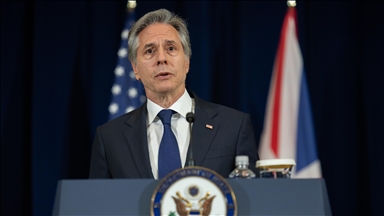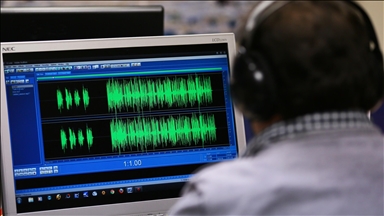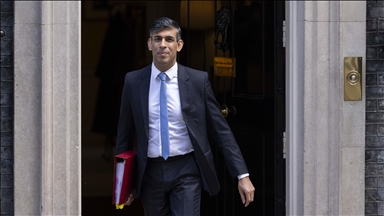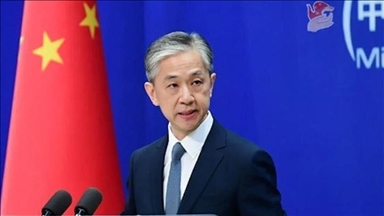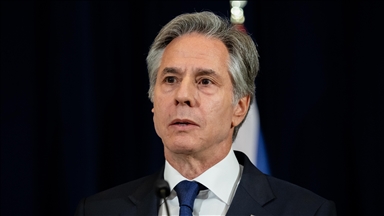ANALYSIS - 'Belt and Road' project: China's new vision and Turkey
Does the Belt and Road project really have the potential to introduce a Chinese alternative to the established world order?

By Emel Parlar Dal

ISTANBUL
U.S. President Donald Trump's 13-day Asia tour, which began on Nov. 5 with Japan and includes, first and foremost, China, South Korea, Vietnam, and the Philippines, is already
Although it is suggested that the visit is outwardly based on the goal of creating a coordination and business alliance to take tougher measures against North Korea, this 13-day diplomacy tour by Trump, the longest Asian tour ever taken by a U.S. president since George H. W. Bush's 12-day visit in 1991, is dropping major hints about the discomfort the U.S. is feeling towards the recent transformation in power balances in Asia.
One such hint is that the region, defined to date by Washington as "Asia-Pacific", began to be conceptualized as the "Indo-Pacific region" starting from before this visit. We may say that the most important reason for this visit as well as the conceptual transformation accompanying it -- beyond the ostentatious North Korean threat -- directly relates to containing or controlling the rise of China, which is now following a global trajectory after its spread over Asia.
The aspect of this Chinese rise that will pose the greatest challenge to the U.S.' position as a superpower is the Belt and Road project, which is China's global strategic partnership vision with pragmatic foundations and a win-win strategy as opposed to the security-related tensions in the Asia-Pacific region.
Does the Belt and Road project really have the potential to introduce a Chinese alternative to the established world order? What countries, multilateral structures and regions constitute the main partners of the project?
And how important are Turkey and the Baku-Tbilisi-Kars (BTK) railroad project to this massive undertaking, considering that the current final destination of this project (Kars) is a Turkish province?
Is Belt and Road main pillar of China's new world vision?
At a time when the basic paradigms of the international order are being questioned once again, China is the focal point of almost every other analysis because of its position in the international hierarchy and because it is seen as possessed of the greatest potential to develop new alternatives.
Indeed, it would not be wrong to argue that China has in recent years been transforming its infrastructure-based activities and foreign aid-based activities, which it has independently carried out for many years, especially in the
What is currently on display in the showcase of this vision, being advertised in an increasingly audible and visible fashion since the 2000s, is -- as it is called now -- "Belt and Road", which was originally called "One Belt, One Road" (OBOR) by Chinese President Xi Jinping when he first announced it in 2013.
As was stressed by Xi Jinping during his long speech at the 19th Communist Party Congress held in October, China is now seeking to shape its global strategy in search of a "new" order in a "new" era.
In this context, while consolidating its new geo-economic and
Through this project, which is trying to connect Asia, Europe and Africa together with land and sea routes and economic corridors, China takes interest in not only the infrastructure projects that would provide the said connections; it also considers steps towards policy cooperation, the joining together of activities, unimpeded trade, financial integration and establishing ties between peoples among the project's goals; steps that will hopefully facilitate the efforts to keep these connections smooth and operational.
The project, which will connect the Chinese hinterland to Europe by road via Central Asia, will also be connecting Chinese ports to Europe by sea, calling at ports in South East Asia and Africa.
In addition to these, the project will incorporate the economic corridors of China-Mongolia-Russia, New Eurasia, China-Central Asia-Western Asia, China-Pakistan, Bangladesh-China-India-Myanmar and China-the Indochina Peninsula.
In addition to massive investment agreements signed to date, worth hundreds of billions of dollars, the Silk Road Fund and the Asian Infrastructure Investment Bank, established by China to finance the project, provide significant clues about the holistic structure of the project.
Likewise, China's emphasis on the safety of all roads and transit routes within the framework of the project is one of the important dimensions of this pragmatic approach regarding the sustainability of the project.
In fact, this project can be regarded as the locomotive of Xi Jinping's vision of becoming an equal superpower alternative to the U.S.; a vision that took Jinping years to formulate; a vision that has been carrying China above and beyond being merely a regional hegemon in Asia.
One of the first balancing efforts of the U.S. under Trump in the face of such a possibility [of China becoming the new superpower] came in the form of steadily growing convergence with India and Japan.
By
Well, with this convergence taking place in Asia-Pacific through the American driving force, what countries and which multilateral groupings and regions
Strategic partners of 'Belt and Road'
China, as already mentioned, offers a global partnership strategy based on a win-win concept with the Belt and Road project, where each country can be a stakeholder regardless of normative conditions or loyalties.
The sheer number of the countries taking part in the project -- 69 so far, including China -- demonstrates the degree to which the Belt and Road project has been received
Another important point that needs to be emphasized here is that China has been trying to activate the Belt and Road project not only through the bilateral relations it has developed but through the regional and interregional multilateral structures, such as the Shanghai Cooperation Organization (SCO), ASEAN + China, the Asia-Pacific Economic Cooperation Forum (APEC), the Asia-Europe Summit, the Asia Cooperation Dialogue, the Conference on Interaction and Confidence-Building Measures, the Chinese-Arab Cooperation Forum, the China-Gulf Cooperation Council Strategic Dialogue, the Economic Partnership of Greater Mekong Sub-Region, and the Central Asian Regional Economic Cooperation (CAREC).
The key strategic partners of the Belt and Road will be Central Asian countries through which the land links that will constitute the main pillar of the project pass, and of them, three countries stand out: Kazakhstan, Kyrgyzstan and Uzbekistan, which were participants of the Belt and Road Forum last May.
In the discussions at the Forum, the railway link between China-Kyrgyzstan-Uzbekistan had come to the forefront as the most important infrastructure project that the project promises for the future of Central Asia.
Outside of China, Pakistan and Indonesia particularly stand out among those countries home to a number of projects already launched as part of China's massive initiative. China signed agreements with Indonesia, already one of the economic corridors of the project, for the financing of over 50 projects, especially in 2015.
Africa is the most important region that stands out in terms of the sea routes of the project. Djibouti, Ethiopia, Gabon, Ghana, Kenya, Mozambique, Egypt, Senegal, Tanzania, and Tunisia are among the areas where the project takes on the greatest intensity continent-wise.
In the African leg of the project, Egypt stands out particularly, because China sees the Suez Canal as one of the most important transit points of the project and is already one of the biggest investors in the development of the canal.
In short, with the Belt and Road project, China is creating strategic partnerships in Central Asia, South East Asia, and Africa as the basis for its new foreign policy vision.
Where does Turkey stand in this partnership vision and what are Turkey's main concerns?
What is Turkey's position with regard to 'Belt and Road'?
The "Belt and Road International Cooperation" forum, also known as the "Modern Silk Road", held on May 14-15, 2017 in Beijing with the participation of the heads of states and governments of 29 countries, including Turkey, is an important cornerstone to understand the project's expectations from Turkey, Turkey's actual capacity as well as the current difficulties it has.
Unlike most European states, Turkey has high expectations from this mega trade and transportation project, considered the most important project of this century.
More than anything else, this project seems to overlap with Turkey's own development goals and the new role it has designed for itself as well as the ideological infrastructure of this role in the changing post-western international system, in which power and competition are gradually shifting from the Global North to the Global South.
It is undoubtedly not a surprising development that Turkey has been seeking new alternatives and partnerships in international politics in this new era marked by ups and downs in its relations with the West, and following a strategy of convergence with China, the most powerful state of the Global South, because of a dwindling capital flow owing to these ups and downs.
Beyond the economic and commercial expectations -- they are
We can additionally mention the positive contributions that may arise from the project to Turkey's regional and global leverage, the roles it plays, and its international image.
Indeed, President Recep Tayyip Erdogan's statement just before the Belt and Road Forum -- "Our convergence with China will create a significant impact in the world" -- illustrates the above observation.
In which leg of the project is Turkey situated and how does it contribute to it? We need to first mention the Baku-Tbilisi-Kars railway, whose construction began in 2007. It was inaugurated at the Port of Baku in Alat two weeks ago and is situated at the middle belt of the Iron Silk Road, which aims to establish an uninterrupted link between Beijing and London.
Another initiative is also worth mentioning: a high-speed train
Turkey is making an important contribution to the Iron Silk Road, having completed the middle belt of the Beijing-London line with the Marmaray [the world's first undersea railway] and the Yavuz Sultan Selim Bridge -- the third on the Bosporus Strait -- both of which had been designed as part of the Iron Silk Road.
The BTK railway has a total length of 838
It is planned that the BTK line, whose current capacity is expected to increase to 3 million passengers and 17 million tons of cargo annually, will be carrying Chinese merchandise to the Caspian Sea and Baku's Alat Port by way of Kazakhstan and Turkmenistan, and eventually to Europe through Georgia and Turkey.
Another feature of the BTK is that it will shorten the China-Europe route by about 7,000
In the same manner, with this new project, it is estimated that a significant portion of the freight traffic between China and Europe will shift from Russia to this particular route.
Turkey's reservations, and expectations from China
Turkey, on the other hand, does have its concerns about China's historic project. Despite acting less warily of the project than its European allies, Turkey is focusing on the possibility that the project might further widen the already yawning gap in the import-export balance of its trade with China.
According to the Turkish Statistical Institute's (Turkstat) figures on 2016, Turkey's imports from China stood at $25 billion whereas its exports to it were worth a mere $2.3 billion. What is striking here is, Turkey's exports to China have gradually decreased since 2013 while its imports have remained around the same level.
Again, according to Turkstat data, Chinese exports have also seen a gradual decrease since 2013 whereas its imports have remained around the same levels. According to Turkish officials, this 10-fold difference between exports and imports is far from sustainable.
Therefore, Turkey must increase its exports to China to equal at least a half of its imports to strike a desirable balance, and the two countries must reach an agreement for China to offer Turkey greater access to its domestic market.
Likewise, we observe that Turkey, just like its European allies, is expecting China -- an advocate of globalization and liberalization in economics -- to lift the quotas and restrictions on foreign investors in its domestic market and to discard the rules that
All these concerns set aside, given the economic corridors in the Belt and Road project and the initiatives China has separately established with certain countries, it is clear that China is conferring an important role on Turkey, albeit not a primary or pivotal one.
In general, it can be assessed that Turkey's role in the project is being shaped by how the Chinese-Russian competition is reflected on Central Asia, Caucasia and the Middle East, a region Turkey is a part of.
With this project, China is containing its two chief rivals Russia and India with secure alternative routes, through which it is creating itself new spheres of trade and security.
In the same way, it can be predicted that China will try and negate the Trans-Pacific Partnership (from which it has been excluded), whose infrastructure saw completion during the Obama era.
This partnership envisages that the U.S. can enjoy free trade with Southeast Asian and Oceania countries even though President Donald Trump claims that the U.S. will withdraw from it.
When assessing the Turkey leg of the project, we need to consider these geo-economic elements as well as all other dimensions, including security. Such a comprehensive assessment is very important if we do not wish for this win-win mentality -- the primary reason for the project -- to turn into a loss for Turkey.
Last but not least, the Belt and Road project might as well serve as an example of similar transportation and transit routes that Turkey may consider developing on its own initiative in the years to come and of the new initiatives of regionalism that it may help to shape.
*Opinions expressed in this article are the author’s own and do not necessarily reflect the editorial policy of Anadolu Agency.
Anadolu Agency website contains only a portion of the news stories offered to subscribers in the AA News Broadcasting System (HAS), and in summarized form. Please contact us for subscription options.


